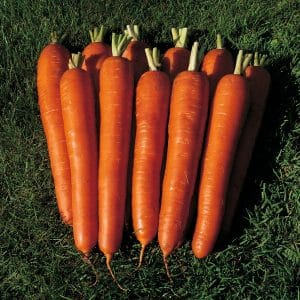Late-ripening and high-yielding carrots "Emperor": description of the variety
Emperor carrots are a variety that will always delight you with a high yield - up to 7 kg per square meter. The variety appeared relatively recently, but has already managed to win the hearts of many gardeners with its excellent taste and attractive appearance. Let's get to know him better.
Description of the variety
The Emperor variety is recommended for cultivation in the central regions of Russia and in the middle zone with a temperate climate. Experts advise planting it on small farm plots and vegetable gardens.
Origin
The Emperor was bred by breeders from the Moscow and Tula regions in 2005. A year later it was included in the State Register of Breeding Achievements of the Russian Federation.
Distinctive features, appearance
The variety is considered late-ripening - 120-135 days pass from germination to technical maturity.
Reference. Carrots are valued for containing a large amount of vitamin A. Per 100 g - 20.6 mg.
Root vegetables have the following features:

- the fruits are smooth and beautiful;
- cylindrical shape with a blunt tip;
- the color is bright orange with red splashes;
- the pulp is juicy and dense;
- the core is small;
- weight – 90-180 grams;
- length – 20-25 cm;
- the taste is sweet.
The eyes are shallow, almost invisible, which makes cleaning much easier.
Description and characteristics of the plant
The leaf rosette of the variety is semi-vertical. The leaves are long with varying degrees of dissection and bright green in color.
Productivity
With proper care, 55 tons of carrots are harvested from 1 hectare. And from 1 sq. m of planting – from 5.5 to 7 kg.
How to grow
Before you start sowing carrot seeds, familiarize yourself with the peculiarities of its cultivation.
Dates, scheme and rules of planting
Sowing of the Emperor variety begins in late April - early May. There is an option for sowing carrots in the summer - in early July.
When choosing a site for planting, we take into account what crops grew on it last season.
The following are considered bad predecessors:
The best option for carrots would be soil after potatoes, onions, tomatoes, cucumbers or lettuce.
Important! The optimal soil for carrots is loam or sandy soil with high humidity. When planting on chernozem, mulch is carried out with the addition of sawdust and river sand in a 1:1 ratio.
To get beautiful, even and tasty fruits, it is important to properly prepare the garden bed. To do this, for 2 sq. m of land use the following fertilizers:
- 4 buckets of compost;
- 2 buckets of peat;
- 2 buckets of sand;
- 100 g nitrophoska.
The composition is applied under digging and left for a couple of days to settle. Then the bed is well leveled so that the soil is soft and without lumps.
Attention. There is no need to treat the seeds before planting. They are produced in the form of dragees, that is, they are in a shell of concentrated mineral fertilizers.
Before planting the seed, be sure to water the soil so that the shell dissolves faster. Carrots are planted by making shallow furrows - the optimal planting depth is 2-3 cm. Seeds They are placed at a distance of 1.5 cm from each other, and 20-25 cm are left between the rows. Then they are sprinkled with earth.
Care
Carrots, like any other crop, need proper care. It consists of the following agricultural practices:

- When the sprouts reach 3 cm, thin out, leaving 2 cm between them.
- When the carrots reach a diameter of 1 cm, thin out again, leaving gaps of 5-6 cm.
- Be sure to weed the plantings to remove weeds. After weeding, loosen the soil between the rows. This helps to better saturate the roots with oxygen.
- Watering plants after germination for two weeks is carried out 2 times a week, spending per 1 sq. m 3-4 liters of water. Then the volume is increased to 5-7 liters. Shortly before harvest, watering is stopped.
There is no need to fertilize the plantings within a month. The seeds already contained the necessary complex of minerals. Then you can do it several times feeding chicken droppings.
Nuances of cultivation and possible difficulties
The variety is demanding on moisture, so follow the watering regime. Do not forget to loosen the soil so that a crust does not form. Remove weeds, otherwise they will not allow root crops to grow actively.
The variety can be attacked by pests:
- Medvedka. The insect lives underground and eats fruits and roots. The soil insecticide Medvetox is used against it.
- Wireworm. They fight it using special preparations or harmless traps. To do this, fresh potatoes or carrots are placed on wooden sticks and buried in the ground. After some time, the traps are removed along with the pest and destroyed.
- Carrot moth. An infusion prepared from tomato shoots is effective against the pest: 2 kg of chopped green tops, leaves and shoots are poured into 10 liters of hot water and infused for 5-6 hours. Then the resulting liquid is diluted in a ratio of 1:4, a little grated soap is added and the plantings are treated.
The Emperor is immune to many diseases:
- late blight;
- rhizoctoniasis;
- Alternaria blight;
- bacteriosis;
- brown spot.
However, root vegetables can be affected by:
- Powdery mildew. It occurs in moist soil. It is manifested by the presence of a white coating on any part of the plant. Over time, such places become hard and crumble. To combat the disease, fungicides “Baleton” or “Skor” are used. They are used in accordance with the instructions.
- Cercospora blight. The disease is characterized by the presence of brown spots on the foliage. For prevention purposes, it is important to adhere to crop rotation and spray plants with Bordeaux mixture.
All chemical treatments are carried out at least 30 days before harvest. Please read the instructions for use first.
Collection, storage and use of crops
Root crops are harvested upon reaching technical maturity. So, when planted in May, the harvest is harvested in late August or early September. If carrots are planted in July, then harvesting takes place in October. To do this, root vegetables are dug up with a pitchfork and pulled out with your hands. Then cut off the tops, leaving 4-5 cm from the base.
Then the crop is dried for several hours directly on the beds under the sun's rays. If the weather is rainy, then the vegetables are brought into a dry room and dried for 5-6 hours. Then the fruits are sorted, leaving smooth, undamaged and unaffected by pests. They are put in storage boxes. The vegetable is stored well in the cellar at a temperature of +3..+5°C.
The variety is excellent for both fresh consumption and processing. Vitamin juices and purees are prepared from root vegetables. Carrots are also used for cooking first and second courses and as a side dish.
Advantages and disadvantages of the variety
The Emperor has many advantages:
- the fruits are the same in size and have an even, beautiful shape;
- good transportability: carrots do not lose their quality during long-term transportation;
- can be stored for up to 9 months;
- stable yield up to 7 kg per sq. m;
- sweet taste and juiciness;
- resistance to many diseases.
Flaws:
- the soil for planting must be soft, loose, well dug, otherwise the root crops will grow clumsy with many side roots;
- relatively low percentage of germination.
Farmer reviews
Most summer residents note many positive aspects of the variety. They enjoy the bountiful harvest, long shelf life, and shape and sweetness of the root vegetables.
Victor, Ekaterinburg: «Emperor carrots are a godsend for those who are very busy and economical. There is no special need to care for the plantings. The fruits are very large and juicy. Their keeping quality is excellent. You can store it all winter.”
Ilona, Izhevsk: “I learned about this carrot about 5 years ago. But then little was known about her. The variety appeared recently. I planted a bed and I liked these carrots. It is very tasty, almost without a core. It stores great if you follow all the rules."
Alexander, Dnepropetrovsk: “I have always grown several varieties of carrots on the plot. Among them was the Emperor. His harvest is much larger than others. And minimal maintenance is required. The main thing is to avoid drought and water regularly. I also fertilize a couple of times a season. Now I’ve decided to leave only him.”
Conclusion
Among the new carrot varieties, Emperor is noted as the most promising, as it is resistant to many diseases, requires only standard care, has a good presentation and excellent taste.